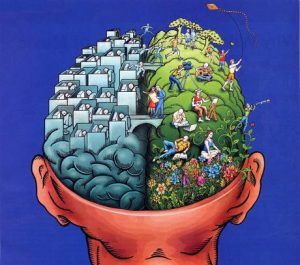We are hardwired for safety and survival and that involves communication both emotionally and rationally. As social beings we are designed to connect. We have our social engagement network at our brainstem, our emotional attachment network higher up within our mammalian brain, at the amygdala, and our cerebral cortex rests on top. All these structures are two sided.
“Right and left hemisphere are involved in absolutely everything but in a consistently different way.”
Iain McGilchrist
Although our brain is separated by a thick band of fibrous tissue called the corpus callosum, current research shows that there is not an equal split of tasks ‘left brain’ for reason and a ‘right brain’ for creativity.’ For our survival, we have evolved to move between the two hemispheres of our brain so that our whole brain functions to process incoming information, and to communicate in order to create meaning from our environment. We have evolved into beings that speak, are rational, emotional, and creative.

How we pay attention is key
According to psychiatrist and researcher Iain McGilchrist, the way we pay attention determines our world-view. We have grown two ways of seeing the world at the same time. We are capable of simultaneously using both hemispheres of our brain to have one whole, non-dualistic version of the world.
McGilchrist explains the following traits:
“Only ½ of our brain sees things in bits and pieces out of context and action on one another in a linear fashion. . . to produce a predictable outcome. The half of our brain that sees least is left hemisphere. It has a narrow beam– the kind paid by an animal locked onto its prey. In human’s it is designed for grasping, [it]- controls the right hand, and helps us manipulate rather than understand the world. It is confident, tends to be black and white, and jumps to conclusion. It sees linear relationships between “doer” and “done to.”
The other kind [of attention] paid by the right hemisphere . . . is a wide-open lens – it is vigilant, sustaining, and without preconceptions. It is designed to look out for whatever else is going on in the world, while we are grasping and holding on.” [A predator with its prey is aware of the environment in case another beast were to come and poach from him].
“We see the whole and relate to it to understand the world from the right hemisphere, rather than manipulate the world. This form of attention is more tentative, less certain, more interested in shades of meaning. . . Unfortunately the Left Hemisphere has little insight into its limitations. It is infinitely optimistic. On a self-rating scale it consistently overestimates its strength while the Right hemisphere has a tendency to underestimate its own value”.
McGilchrist reminds us that we need to simplify and stand apart to manipulate things, and we also need to belong to the world and understand the complexity of the relationships between and with our environment. We need both ways of paying attention. In both types of attention paying, it is our physical presence that is the interpreter and bearer of experiences.
What does this mean for us in our moving life?
Last month, I wrote about ‘Sudoku for your body” by bringing attention to the qualities of each of the three planes of space available to us. Moving from one plane to another, focusing on shifting bodily sensations, requires using your whole self, both hemispheres of your brain are activated as it receives perceptions from your body.
Review
Moving from the Horizontal plane up or down into to the Vertical plane brings an experience of flattening in our torso, because what is shared between the 2 planes is the side-to-side force.
Moving through the experience of up and down to slide into the Sagittal plane’s primary forward and backward stress causes a steepening experience.
Moving through the mutual forward and backwardness into the primary sideways pull of the horizontal plane causes a feeling of being suspended through space.
I have described a three-ring circuit moving from 1 plane to another using both left and right hemispheric information. Left hemispheric explanations of shared spatial pulls, right hemispheric description of the feeling in my body.
Using Only Left?
I can simplify my explanation into a more linear description: starting with my right arm reach into the left back corner, move to high right, then forward low, return to left back.
If I continue to move in this manner, my movement quality may become linear and the chances of me looking and feeling robotic and mechanical increase. This is a left hemispheric approach to moving. Chances of me continuing the exploration decreases because I will say to myself, “yeah I got it, this is boring, what next?”
Air Force Airman 1st Class Jacob Masters gives it his all during the Bench Rep-Out competition put on by Morale, Welfare and Recreation Fitness at U.S. Naval Station Guantanamo Bay, July 4. Masters finished 3rd place by bench pressing 205 lbs., 24 times. JTF Guantanamo conducts safe, humane, legal and transparent care and custody of detainees, including those convicted by military commission and those ordered released by a court. The JTF conducts intelligence collection, analysis and dissemination for the protection of detainees and personnel working in JTF Guantanamo facilities and in support of the War on Terror. JTF Guantanamo provides support to the Office of Military Commissions, to law enforcement and to war crimes investigations. The JTF conducts planning for and, on order, responds to Caribbean mass migration operations.

Using a rote, automaton, number of repetitions, ‘targeting’ muscle group approach to exercise or moving is often what happens to people who join a gym. The exercise machines only allow you to move in a planal fashion. We get very bored doing repetitions, and after three months we stop going to the gym.
When we are only working at strengthening the muscular system with little acknowledgement of other systems of the body (the whole), we can easily be injured. Left hemispheric thinking is a useful process for gaining information, and setting procedures, we need it, but it does not create relationship.
Layering in the Right
Images, and poetic or descriptive language give us the right hemispheric metaphoric explanation of the experience. “A picture paints a thousand words”, words that accompany pictures to illuminate or explain intent, provides a whole brain understanding.

I can experience everyday tasks as opportunities for fitness, to reduce ‘routine’, how I climb stairs everyday can replace using a stair master. In an exercise situation, if repetition bores me, I can shift to an awareness of how I am progressing through each ‘set’ of my routine. How I pay attention is going to provide me with different information about the experience, ideally I will use a narrow beam and a broad beam to keep my movement experience alive.
To have a whole brain experience, once I know the pathway I am traveling (i.e. a 3 ring circuit), I can layer in many different ways of proceeding. I can go more inner, deeper into my organs to explore the sequence, and discover what that means to me. Or, I can explore the flattening steepening suspending sensations of my torso to have another perspective of moving in space. Both of these are whole brain experiences. (Next month we will look at the 3 ring circuit from 2 other systems of the body.)
McGilchrist reminds us that we need to simplify and stand apart to manipulate things, (in exercise it is knowing the sequence – the parts) and we also need to belong to the world and understand the complexity of the relationships between and with our environment (in exercise, it is knowing the whole and relationship of self to the environment or environment to self). We need both ways of paying attention. In both types of attention paying, it is our physical presence that is the interpreter and bearer of experiences.
When we are embodied, we take time and are living our experiences with consciousness. This involves forming new relationships to similar information by incorporating context. In so doing we deepen our understanding and relationships. We have evolved into beings that speak, are rational, emotional, and creative. This is neither Right or Left shifted thinking – it is, whole body, brain included “both/and” non-dualistic Living.











